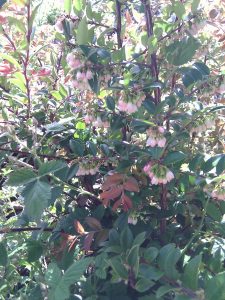When I saw this Evergreen Huckleberry bush in my new neighbourhood, I immediately felt at home. I came across this lovely plant as it struggled for survival in the midst of logging debris, choked out by blackberry brambles.
In one of our previous residences we planted an “edible hedge” along one side of our property and included Evergreen Huckleberry, Vaccinium ovatum, native to some parts of BC. Sometimes it is referred to as the California Huckleberry because it is also prevalent there or the Winter Huckleberry because the berries are harvested late in the year and are thought to taste better if the fruit has experienced frost.
The Evergreen Huckleberry is found on the west side of the Cascade Mountains from British Columbia to California. In BC it is mostly found on lower Vancouver Island and the coastal areas of the lower mainland and is very common in second growth forests, especially along edges and openings[i]. In the spring the new growth has a reddish tinge (as you can see in the picture) that turns dark green as the plant matures. As the name suggests it stays green year round and doesn’t lose its leaves in winter. The flowers are pinkish-white and bell-shaped. They hang under the leaves in long clusters, producing berries that are small but relatively easy to pick. Like the Red Flowering Current that I mentioned in the last blog, the flowers attract hummingbirds, butterflies and other pollinators and this one was buzzing with bees.
The Evergreen Huckleberry is a traditional food plant of BC Indigenous Peoples. According to Kuhnlein and Turner (1991) the Sechelt, Comox, Straits, Halkomelem, Lower Nlaka’pamux Salish and Nuu-chah-nuth of Vancouver Island and the west coast, all harvested the berries.[ii] Traditionally the berries were eaten fresh, usually with oil. They were also sun or smoke dried, partly mashed, pressed into cake form, and wrapped in leaves or bark.[iii] Today they are made into jam or used in baking. They are delicious in muffins or scones.
The leaves of the Evergreen Huckleberry may be dried and have been used for medicinal purposes. Teas made from the leaves have been used to lower or modify blood sugar levels and therefore are believed to be useful in treating diabetes. It is also believed that they stimulate appetite, and have astringent and antiseptic qualities that are useful in urinary disorders. [iv]
I’ll let you know whether I get any berries in the fall. I might even get enough to make my Hot Huckleberry Preserve.
[i]. E-Flora BC: Electronic Atlas of the Flora of British Columbia. http://linnet.geog.ubc.ca/Atlas/Atlas.aspx?sciname=Vaccinium%20ovatum
[ii] Kuhnlein, V. & Turner, N. (1991). Traditional plant foods of Canadian Indigenous Peoples: Nutrition, botany and use. New York:Routledge.
[iii] USDA Plants, https://plants.usda.gov/plantguide/pdf/cs_vaov2.pdf
[iv] Practical Plants (n.d.). Vaccinium ovatum EVERGREEN HUCKLEBERRY. http://practicalplants.org/wiki/Vaccinium_ovatum

